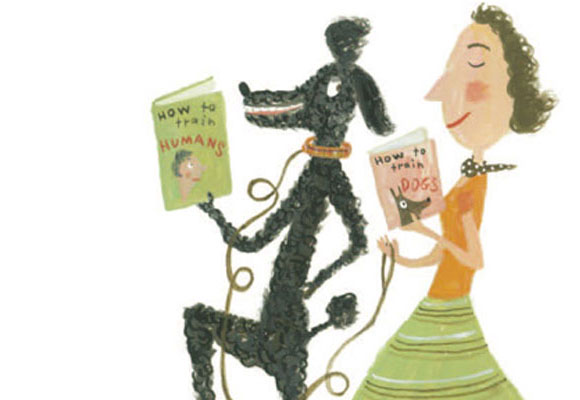First published in L.A. Times Magazine, Nov. 30, 2008
Every Pooch Needs a Little Emily Post
When I go to a restaurant and see kids running out of control, bothering everybody, their parents sitting by oblivious, I think, What’s the matter with these people? And yet, when an untrained younger Izzy, at 30 pounds, would jump up and paw people, I thought he was the cutest thing on earth. That’s when my husband, David, the most easygoing guy in town, stepped in and said, “Enough—everyone here needs to be trained.”
I knew nothing about training when we got Izzy. I’m a dog person. I like all of them unconditionally. And I’d rather let Izzy do anything he wanted than have to say no to him. I certainly don’t like it when people say no to me. In short, I’m an enabler. So when Izzy made a meal out of a pair of Louboutin shoes and my mother’s custom-made bra when she was visiting one summer (she still mentions it every time she sees Izzy), it occurred to me something had to be done.
Yes, I have come around to agreeing the human has to be in control. When we’re in charge, our dogs feel secure.
These days, it’s a good thing Izzy is trained. I mean, he’s a big, beautiful, charcoal gray 82 pounds. He likes to go right up to people, not realizing they might be frightened of him. “Yes,” I say, “He’s very friendly.” But if you saw King Kong coming at you, how friendly do you think he’d seem? This is important because we like to take our dog with us as much as possible: to our offices, where there are all sorts of people walking around, and to restaurants. (Yes, that’s us in the winter, sitting outside under a heat lamp, waiters freezing their asses off to serve us.) And when Izzy does have to stay home, we like him to go voluntarily into his large crate and not look at us like he’s heading to the guillotine.
My mantra is it’s important to find training that’s right for both of you. All work should be done with loving, positive reinforcement. Even dogs that need a stronger approach should never be scared or hurt. Interview trainers before you commit. How many sessions will the dog need? What will be accomplished in each session? How much owner involvement is required? Also ask about methods: Are shock collars used, or do they use positive reinforcement? And most important, ask for references.
Regardless of how training is done, there are a few rules every dog should know: He should be able to sit, stay, come when called and not jump. Yes, that goes for little dogs, too. A dog jumping up on friends, family and strangers is not cute—in fact, it’s quite annoying. If I want another dog to put his paws on me, I will ask for it, thank you. And no matter how well trained you think your pet is, showing off by having him go leashless on a city street is not a good idea. Things happen even to the most perfectly trained animal. There are leash laws for a reason!
Of course, good canine manners shouldn’t be reserved for humans. They need to extend to interactions between dogs: Izzy was lying peacefully next to us at a restaurant (outside, naturally) as a lady with a little Chihuahua was seated at the next table. When she saw Izzy, she said, “Don’t worry, my Sweetie’s very friendly—loves everyone.” All Izzy did was glance up, and Sweetie went nuts, growling, snapping and desperately trying to leap out of the woman’s arms.
Barely able to control her little darling, she kept repeating, “Sweetie’s never done that before,” while the whole restaurant watched Izzy lying as calm as a Zen master. Sweetie’s owner left the restaurant in a huff, still desperately trying to control her snapping, barking, writhing dog. As she left, she said, “It must be some scent that dog is giving off, because, you know, Sweetie’s…” At that point, the whole crowd joined in to recite the refrain: “…never done that before.”
The truth of the matter is that Sweetie would be worlds better if her pain-in-the-neck owner had a few training sessions.
Instruction is available to fit any budget. There are group classes at local parks, as well as lots of great individual trainers, including Annica Evans in West L.A. (310-729-7942, evansdogtraining.com) and Heidi Le Beau (323-850-7027) in Los Angeles, a former vet tech (always a good thing). If you can afford to splurge (and I’m talking five figures), Gina Grossman is the city’s best-kept secret (as in, email only: TheDogGenius@sbcglobal.net). Those who have sent their pooches to her say that after a month, you’ll think your dog is a member of Mensa. I’ve heard that owners of seriously aggressive or out-of-control dogs have gotten great results from “dog behaviorist” Kyle Schwab (818-424-1757, kyleschwab.com).
Do-it-yourselfers should check out any of these how-to books: Mine! A Practical Guide to Resource Guarding in Dogs, by Jean Donaldson; Before and After Getting Your Puppy: The Positive Approach to Raising a Happy, Healthy & Well-Behaved Dog, by Dr. Ian Dunbar (all of Dunbar’s books are good); The Loved Dog: The Playful, Nonaggressive Way to Teach Your Dog Good Behavior, by Tamar Geller and Andrea Cagan; and, of course, Cesar’s Way: The Natural, Everyday Guide to Understanding & Correcting Common Dog Problems, by renowned Dog Whisperer Cesar Millan and Melissa Jo Peltier.
Izzy has been through it all. I am trying to be consistent with boundaries and still cater to his every wish. I do occasionally slip him a bit of bread from the table…but only if he’s lying down. He has been respectful of that so far. All of our training has finally kicked in—for me. Izzy got it right away.
P.S.: Please adopt or rescue a dog.
illustration by jessie hartland

Recent Comments